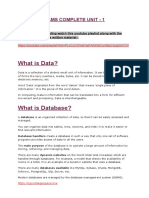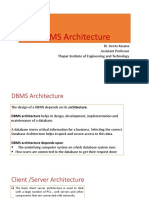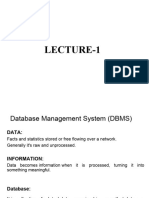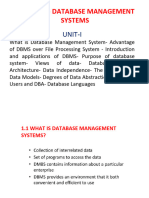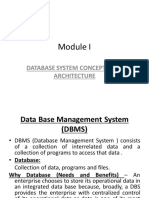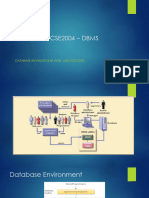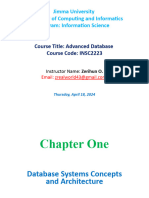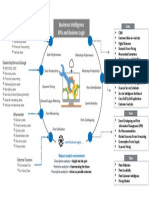Unit No.1 Introduction DBMS - Concepts & Architectures
Unit No.1 Introduction DBMS - Concepts & Architectures
Uploaded by
Padre BhojCopyright:
Available Formats
Unit No.1 Introduction DBMS - Concepts & Architectures
Unit No.1 Introduction DBMS - Concepts & Architectures
Uploaded by
Padre BhojOriginal Title
Copyright
Available Formats
Share this document
Did you find this document useful?
Is this content inappropriate?
Copyright:
Available Formats
Unit No.1 Introduction DBMS - Concepts & Architectures
Unit No.1 Introduction DBMS - Concepts & Architectures
Uploaded by
Padre BhojCopyright:
Available Formats
Unit No.
1 Introduction DBMS- Concepts & Architectures
Unit 1.Introduction DBMS – Concepts & Architectures
1.1 Database and Need for DBMS, Characteristics of DBMS
1.2 Database 3-tier schema (ANSI/SPARC) and system architecture of DBMS
1.3 Views of data- Schemas and instances, Data Independence
1.4 Centralized, Client-Server system, Transaction servers, Data servers, Cloud based servers
1.1 Introduction to DBMS
Database management system is software that is used to manage the database. A Database Management System
(DBMS) is a software system that is designed to manage and organize data in a structured manner. It allows users
to create, modify, and query a database, as well as manage the security and access controls for that database.
Database management system is a software which is used to manage the database. For example: MySQL, Oracle, etc are
a very popular commercial database which is used in different applications. It provides protection and security to the
database. In the case of multiple users, it also maintains data consistency.
DBMS allows users the following tasks:
•Data Definition: It is used for creation, modification, and removal of definition that defines the organization of data in
the database.
•Data Updation: It is used for the insertion, modification, and deletion of the actual data in the database.
•Data Retrieval: It is used to retrieve the data from the database which can be used by applications for various purposes.
1.1 Database and Need for DBMS, Characteristics of DBMS
What is Database
The database is a collection of inter-related data which is used to retrieve, insert and delete the data efficiently. It is also
used to organize the data in the form of a table, schema, views, and reports, etc.
For example: The college Database organizes the data about the admin, staff, students and faculty etc.
Using the database, you can easily retrieve, insert, and delete the information.
Need for DBMS
A Data Base Management System is a system software for easy, efficient and reliable data processing and management.
It can be used for:
•Creation of a database.
•Retrieval of information from the database.
•Updating the database.
•Managing a database.
Characteristics of DBMS
There are so many characteristics of a database management system, which are as follows −
•A database management system is able to store any kind of data in a database.
•The database management system has to support ACID (atomicity, consistency, isolation, durability) properties.
•The Database management system allows so many users to access databases at the same time.
•Backup and recovery are the two main methods which allow users to protect the data from damage or loss.
•It also provides multiple views for different users in a single organization.
•It follows the concept of normalization which is helpful to minimize the redundancy of a relation.
•It also provides users query language, helpful to insert, retrieve, update, and delete the data in a database.
1.2 Database 3-tier schema (ANSI/SPARC) and system architecture of DBMS
Database 3-tier schema (ANSI/SPARC) :-
•The three schema architecture is also called ANSI/SPARC architecture or three-level architecture.
•This framework is used to describe the structure of a specific database system.
•The three schema architecture is also used to separate the user applications and physical database.
•The three schema architecture contains three-levels. It breaks the database down into three different categories.
In the above diagram:
•It shows the DBMS architecture.
•Mapping is used to transform the request and response between various database levels of architecture.
•Mapping is not good for small DBMS because it takes more time.
•In External / Conceptual mapping, it is necessary to transform the request from external level to conceptual schema.
•In Conceptual / Internal mapping, DBMS transform the request from the conceptual to internal level.
1. Internal Level
•The internal level has an internal schema which describes the physical storage structure of the database.
•The internal schema is also known as a physical schema.
•It uses the physical data model. It is used to define that how the data will be stored in a block.
•The physical level is used to describe complex low-level data structures in detail.
The internal level is generally is concerned with the following activities:
1.Storage space allocations.
For Example: B-Trees, Hashing etc.
2. Data compression and encryption techniques.
2. Conceptual Level
•The conceptual schema describes the design of a database at the conceptual level. Conceptual level is also known as
logical level.
•The conceptual schema describes the structure of the whole database.
•The conceptual level describes what data are to be stored in the database and also describes what relationship exists
among those data.
•In the conceptual level, internal details such as an implementation of the data structure are hidden.
•Programmers and database administrators work at this level.
3. External Level
•At the external level, a database contains several schemas that sometimes called as subschema. The subschema is used
to describe the different view of the database.
•An external schema is also known as view schema.
•Each view schema describes the database part that a particular user group is interested and hides the remaining
database from that user group.
•The view schema describes the end user interaction with database systems.
DBMS Architecture
• The DBMS design depends upon its architecture. The basic client/server architecture is used to deal with a large number
of PCs, web servers, database servers and other components that are connected with networks.
• The client/server architecture consists of many PCs and a workstation which are connected via the network.
• DBMS architecture depends upon how users are connected to the database to get their request done.
Types of DBMS Architecture
1-Tier Architecture
•In this architecture, the database is directly available to the user. It means the user can directly sit on the DBMS and
uses it.
•Any changes done here will directly be done on the database itself. It doesn't provide a handy tool for end users.
•The 1-Tier architecture is used for development of the local application, where programmers can directly
communicate with the database for the quick response.
2-Tier Architecture
•The 2-Tier architecture is same as basic client-server. In the two-tier architecture, applications on the client end can
directly communicate with the database at the server side. For this interaction, API's like: ODBC, JDBC are used.
•The user interfaces and application programs are run on the client-side.
•The server side is responsible to provide the functionalities like: query processing and transaction management.
•To communicate with the DBMS, client-side application establishes a connection with the server side.
Fig: 2-tier Architecture
3-Tier Architecture
•The 3-Tier architecture contains another layer between the client and server. In this architecture, client can't directly
communicate with the server.
•The application on the client-end interacts with an application server which further communicates with the database
system.
•End user has no idea about the existence of the database beyond the application server. The database also has no idea
about any other user beyond the application.
•The 3-Tier architecture is used in case of large web application.
Fig: 3-tier Architecture
1.3 Views of data- Schemas and instances, Data Independence
View of data in DBMS
Abstraction is one of the main features of database systems. Hiding irrelevant details from user and providing abstract
view of data to users, helps in easy and efficient user-database interaction. In the previous tutorial, we discussed the
three level of DBMS architecture, The top level of that architecture is “view level”. The view level provides the “view of
data” to the users and hides the irrelevant details such as data relationship, database schema, constraints, security etc
from the user.
Schemas:-
It is the definition of the database or it is defined as the description of the database. The overall design of the database is
called database schema. Schema will not be changed frequently. It is the logical structure of a database. It does not show
the data in the database.
The schema is pictorially represented as follows −
Types of Schema:-
The different types of schemas are as follows −
•Physical schema − It is a database design at the physical level.It is hidden below the logical schema and can be changed
easily without affecting the application programs.
•Logical schema − It is a database design at the logical level. Programmers construct applications using logical schema.
•External − It is schema at view level. It is the highest level of a schema which defines the views for end users.
Generally the Database Management System (DBMS) assists one physical schema, one logical schema and several sub or
external schemas.
Database schema refers to the format and layout of the database in which the data will be stored. It is the one thing that
Name Email Phone no
remains the same throughout unless otherwise modified. It defines the structure of what type of data and how it will be
stored.
Example
A database schema for a person will have fields for name, email, phone and address as shown below −
Person
Name Email Phone no
Instance :-
Instance or extension or database state is a collection of information that stored in a database at a particular moment is
called an instance of the database. The Database instance refers to the information stored in the database at a given point
of time. Thus, it is a dynamic value which keeps on changing.
Example
A database instance for the Person database can be (User1,emai.com,11345679,addr) So the person construct will contain
their individual entities in the attributes called as instance. This is shown below −
Person
Name Email Phone no
BOB [email protected] 2343435
JANU [email protected] 5345464
PRIYA [email protected] 2342342
1.4 Centralized Architecture, Client-Server System, Transaction Servers, Data servers,
Cloud based Servers
1. Centralized Architecture
A centralized architecture for DBMS is one in which all data is stored on a single server, and all clients connect to that
server in order to access and manipulate the data. This type of architecture is also known as a monolithic architecture. One
of the main advantages of a centralized architecture is its simplicity - there is only one server to manage, and all clients use
the same data.
However, there are also some drawbacks to this type of architecture. One of the main downsides is that, because all data is
stored on a single server, that server can become a bottleneck as the number of clients and/or the amount of data
increases. Additionally, if the server goes down for any reason, all clients lose access to the data.
An example of a DBMS that uses a centralized architecture is SQLite, an open-source, self-contained, high-reliability,
embedded, full-featured, public-domain SQL database engine. SQLite's architecture is based on the client-server model,
but the entire database is contained within a single file, making it a perfect fit for small to medium-sized applications.
2. Client-Server Architecture
A client-server architecture for DBMS is one in which data is stored on a central server, but clients connect to that server in
order to access and manipulate the data. This type of architecture is more complex than a centralized architecture, but it
offers several advantages over the latter.
One of the main benefits of a client-server architecture is that it is more scalable than a centralized architecture. As the
number of clients and/or the amount of data increases, the server can be upgraded or additional servers can be added to
handle the load. This allows the system to continue functioning smoothly even as it grows in size.
Another advantage of a client-server architecture is that it is more fault-tolerant than a centralized architecture. If a single
server goes down, other servers can take over its responsibilities, and clients can still access the data. This makes the
system less likely to experience downtime, which is a crucial factor in many business environments.
An example of a DBMS that uses a client-server architecture is MySQL, an open-source relational database management
system. MySQL uses a multi-threaded architecture, where multiple clients can connect to the server and make requests
simultaneously. The server processes these requests and returns the results to the appropriate client.
3. Transaction Servers
A transaction server is a specialized type of server that manages the operations of software based transactions or
transaction processing. It manages application and database transactions on a network or Internet, within a distributed
computing environment.
Some of the examples of commercially available transaction servers are:
•Microsoft transaction server ( MTS )
•IBM transaction server
Transaction servers incorporate programming that handles high volumes of message exchanges. This kind of programming
is planned explicitly to deal with enormous volumes of information passage and message traffic in an organization.
How Transaction Server Works:
Suppose, there is a client who wants to access a file from the server, so first of all client makes a connection to the server
using TCP protocol, and the translation of the name address into the IP address is done by DNS.
Then they make a request to the server for the particular information or file. This request contains the command, page
desired, and the protocol or version.
After this, the server reads the request and sends the requested file to the client and it is called response. The response
contains the status line, header files, and the message body containing the information from the database, and this whole
process is called request-response behavior. It might also happen that server denies some information.
Finally, when the client receives the information, the transaction is terminated.
4. Database Servers
Database servers are used to store and manage databases that are stored on the server and to provide data access for
authorized users. This type of server keeps the data in a central location that can be regularly backed up. It also allows
users and applications to centrally access the data across the network. A large number of the databases used in your
organization can be kept on one server or a group of servers that are specifically configured to protect data and service
client requests.
5. Cloud Based Server/ Cloud Server
A cloud server is a pooled, centralized server resource that is hosted and delivered over a network—typically the
Internet—and accessed on demand by multiple users. Cloud servers can perform all the same functions of a traditional
physical server, delivering processing power, storage and applications.
Cloud servers can be located anywhere in the world and deliver services remotely through a cloud computing
environment. In contrast, traditional dedicated server hardware is typically set up on premises for exclusive use by one
organization.
You might also like
- P - C Data Model SpecificationDocument194 pagesP - C Data Model SpecificationNikhil SatavNo ratings yet
- Don TaylorDocument13 pagesDon TaylorSuttisak SuriyachanhomNo ratings yet
- Dbms Unit1Document57 pagesDbms Unit1anshdarock222No ratings yet
- DBMS Unit - 1Document40 pagesDBMS Unit - 1JANMEETNo ratings yet
- Database and Data ModelingDocument31 pagesDatabase and Data ModelingKudakwashe MotsiNo ratings yet
- Introduction of DBMSDocument89 pagesIntroduction of DBMSStory TellingNo ratings yet
- Lecture 1.1.3 - Databases Architecture and Lecture 1.1.4 - Data IndependenceDocument22 pagesLecture 1.1.3 - Databases Architecture and Lecture 1.1.4 - Data IndependenceNojibur Rahman SojibNo ratings yet
- Unit1 - FinalDocument71 pagesUnit1 - FinalRoshan ChoudharyNo ratings yet
- SWE DataBaseDocument56 pagesSWE DataBasenkoloamandineNo ratings yet
- Dbms Unit 1Document65 pagesDbms Unit 1ridham.aurasoftNo ratings yet
- DBMS UNIT-1Document50 pagesDBMS UNIT-1231001165No ratings yet
- Da Tabase Management System: Hassan KhanDocument11 pagesDa Tabase Management System: Hassan KhanHassan KhanNo ratings yet
- Ict 141 NotesDocument87 pagesIct 141 Notespheobenyapola11No ratings yet
- Dbms Unit 1-1Document87 pagesDbms Unit 1-1Raghav SharmaNo ratings yet
- 7286 - 1-Basic Introduction of DBMSDocument5 pages7286 - 1-Basic Introduction of DBMSbwumba23050No ratings yet
- L03 - DBMS ArchitectureDocument33 pagesL03 - DBMS ArchitectureARYAN TYAGINo ratings yet
- DBMS Concepts&architectureDocument39 pagesDBMS Concepts&architectureAASTHA KIETNo ratings yet
- dbms-unit-1_aktuDocument20 pagesdbms-unit-1_aktupaswanraja802No ratings yet
- Unit 3 of MISDocument18 pagesUnit 3 of MISneha9cgpyadavNo ratings yet
- Database System Concepts and ArchitectureDocument50 pagesDatabase System Concepts and ArchitectureHajar Meseeh YaseenNo ratings yet
- Department of Information Technology:: VRSEC III/IV B.Tech VTH Sem DBMS - 17IT2505ADocument12 pagesDepartment of Information Technology:: VRSEC III/IV B.Tech VTH Sem DBMS - 17IT2505ANarasimhareddy MmkNo ratings yet
- Dbms QB Solution Tt-1Document15 pagesDbms QB Solution Tt-1Ojas PatilNo ratings yet
- Dbms Unit-1 - Important PointsDocument58 pagesDbms Unit-1 - Important PointsSathwika DoddarapuNo ratings yet
- Unit 1 - Part 1Document66 pagesUnit 1 - Part 1Pawan KumarNo ratings yet
- CS403 Short Easy NotesDocument28 pagesCS403 Short Easy NotesMUHAMMAD SAADNo ratings yet
- Dbms Unit 1 Acoording To AKTU SyllabusDocument22 pagesDbms Unit 1 Acoording To AKTU Syllabusmukesh.iilm144100% (1)
- PPT2 - DBMS ArchitectureDocument72 pagesPPT2 - DBMS ArchitectureSatyam Kumar SinghNo ratings yet
- Introduction of DB: Database System Concepts and ArchitectureDocument23 pagesIntroduction of DB: Database System Concepts and ArchitectureZahid AhmadNo ratings yet
- DBMS Unit 1 NotesDocument41 pagesDBMS Unit 1 NotesSaisubramanian VNo ratings yet
- Databases 2Document30 pagesDatabases 2Shahzeb BashirNo ratings yet
- Database SchemaDocument9 pagesDatabase SchemaSonam BhatiaNo ratings yet
- CSE - 311L, Lab - 01Document8 pagesCSE - 311L, Lab - 01RK RashikNo ratings yet
- ME DBMS Unit1 FinalDocument139 pagesME DBMS Unit1 FinalSendurusrinivas NadarNo ratings yet
- Database System Concepts and ArchitectureDocument30 pagesDatabase System Concepts and ArchitectureAyush RathoreNo ratings yet
- O o o o o o O: What Is DatabaseDocument20 pagesO o o o o o O: What Is Databasesalman khanNo ratings yet
- Dbms Basics Unit 1Document49 pagesDbms Basics Unit 1Shivaay sharmaNo ratings yet
- MergedDocument393 pagesMergedRAVINo ratings yet
- DBMS Unit 1Document39 pagesDBMS Unit 1ishwardeep.workNo ratings yet
- Unit 1 - Part 1Document44 pagesUnit 1 - Part 1Harsh BhardwajNo ratings yet
- DBMS Unit 1Document100 pagesDBMS Unit 1kaprajitasharmaNo ratings yet
- Database Tier and System ArchitectureDocument19 pagesDatabase Tier and System Architecturemishravivek3500No ratings yet
- DBMS SlidesDocument127 pagesDBMS SlidesAmit KushwahaNo ratings yet
- DBMS Assigment 1Document17 pagesDBMS Assigment 1khairnardipak776No ratings yet
- Database System: Nasreen Akhtar Fast-Nu Chiniot-Faisalabad CampusDocument24 pagesDatabase System: Nasreen Akhtar Fast-Nu Chiniot-Faisalabad Campuswaleed amjadNo ratings yet
- Database Unit1 Notes For ReferenceDocument19 pagesDatabase Unit1 Notes For ReferenceSaban ChoudhuryNo ratings yet
- RDBMS - M01 - C01 - PPT - Overview of Database Management SystemDocument47 pagesRDBMS - M01 - C01 - PPT - Overview of Database Management SystemAman SharmaNo ratings yet
- Unit 1 CS 502Document20 pagesUnit 1 CS 502h15276665No ratings yet
- SESSION 2 - Fundamentals of DBMS - OldDocument39 pagesSESSION 2 - Fundamentals of DBMS - OldsdfaNo ratings yet
- Chapter 2Document17 pagesChapter 2shabbirjamali0% (1)
- Database_Architecture.13068Document17 pagesDatabase_Architecture.13068Sathish KumarNo ratings yet
- Lecture 3 - BCSE302L - DBMS ArchitectureDocument17 pagesLecture 3 - BCSE302L - DBMS Architecturebojon27556No ratings yet
- Chapter 2 Three Level ArchitectureDocument50 pagesChapter 2 Three Level ArchitectureAnkit RajputNo ratings yet
- Dbms Unit 1 Minors - Part-2Document59 pagesDbms Unit 1 Minors - Part-2komaliNo ratings yet
- Media To Upload1700644031Document80 pagesMedia To Upload1700644031Md SahilNo ratings yet
- Mid ExamDocument5 pagesMid ExamFahad RazzaqNo ratings yet
- DBMS Notes - All UnitsDocument77 pagesDBMS Notes - All UnitsvibhavariNo ratings yet
- Chapter 1Document50 pagesChapter 1yishaktumoregideNo ratings yet
- DatabaseDocument15 pagesDatabasesadaf noorNo ratings yet
- DBMS - Lesson 5 - The DBMS EnvironmentDocument13 pagesDBMS - Lesson 5 - The DBMS Environmentkeithrashid8No ratings yet
- Unit I - IntroductionDocument63 pagesUnit I - IntroductionNiveditaNo ratings yet
- 2.Database System Concepts and ArchitectureDocument54 pages2.Database System Concepts and ArchitectureVishu ShahNo ratings yet
- THE SQL LANGUAGE: Master Database Management and Unlock the Power of Data (2024 Beginner's Guide)From EverandTHE SQL LANGUAGE: Master Database Management and Unlock the Power of Data (2024 Beginner's Guide)No ratings yet
- Unit No.3 Trasaction & Concurrency ControlDocument29 pagesUnit No.3 Trasaction & Concurrency ControlPadre BhojNo ratings yet
- Unit No.4 Parallel DatabaseDocument32 pagesUnit No.4 Parallel DatabasePadre BhojNo ratings yet
- Operating System ConceptsDocument102 pagesOperating System ConceptsPadre BhojNo ratings yet
- Operating System Question With AnswersDocument57 pagesOperating System Question With AnswersPadre BhojNo ratings yet
- Mariadb MysqlDocument1 pageMariadb MysqlK2S Business IntelligenceNo ratings yet
- AlhamdulillahDocument5 pagesAlhamdulillahIbnu ManjaNo ratings yet
- Airline-Reservation-System in Java.Document8 pagesAirline-Reservation-System in Java.mindventures0555No ratings yet
- Banking ProjectDocument37 pagesBanking ProjectAman KeshariNo ratings yet
- Class 12 FileHandlingDocument4 pagesClass 12 FileHandlingSaravana KumarNo ratings yet
- 1.-Understanding IfixDocument142 pages1.-Understanding IfixAntonio VerneNo ratings yet
- Safenet Mobilepass User Guide: © 2016 The Emirates Group. All Rights ReservedDocument29 pagesSafenet Mobilepass User Guide: © 2016 The Emirates Group. All Rights ReservedWaiyan LynnNo ratings yet
- 1 Course Materials 2 Prerequisites 3 Course Outline 5 Setup 9 Microsoft Official Curriculum 12 Microsoft Certified Professional Program 13 Facilities 15Document11 pages1 Course Materials 2 Prerequisites 3 Course Outline 5 Setup 9 Microsoft Official Curriculum 12 Microsoft Certified Professional Program 13 Facilities 15Jamal Saad MohamedNo ratings yet
- DMA Model AnswerDocument15 pagesDMA Model Answertemptaccforclg100% (1)
- Database Notes XiDocument6 pagesDatabase Notes XisnpsNo ratings yet
- Top 35 SAP ABAP Interview QuestionsDocument10 pagesTop 35 SAP ABAP Interview QuestionssuhasnwNo ratings yet
- Ss Sys AdminDocument65 pagesSs Sys Adminahmed_497959294No ratings yet
- Release 11i Documentation Titles (11.5.8) Part Number PDFDocument6 pagesRelease 11i Documentation Titles (11.5.8) Part Number PDFmadhu1222No ratings yet
- SOC AnalystDocument13 pagesSOC AnalystvadirajaNo ratings yet
- Understand ADFSDocument3 pagesUnderstand ADFSDisha1No ratings yet
- CX ML Users GuideDocument442 pagesCX ML Users GuideMurthyNo ratings yet
- Joining Data in Tableau 29Document7 pagesJoining Data in Tableau 29Giri RajNo ratings yet
- CN17-PWC-Mayur Mehata-IsA 99 Cyber Security StandardDocument22 pagesCN17-PWC-Mayur Mehata-IsA 99 Cyber Security StandardJuan RiveraNo ratings yet
- Misc 5Document1 pageMisc 5Masum ShahNo ratings yet
- Inventateq IT Business Analyst Course SyllabusDocument13 pagesInventateq IT Business Analyst Course SyllabusAswini SumanthNo ratings yet
- MEGA Solution Footprint V5Document17 pagesMEGA Solution Footprint V5Wissam ShehabNo ratings yet
- Api RestDocument414 pagesApi RestSantos SeniorNo ratings yet
- Wits 2019 8723839Document5 pagesWits 2019 8723839Nagaraj LutimathNo ratings yet
- Final 225Document27 pagesFinal 225Darrell GoodwinNo ratings yet
- Lab 2 - CLCDocument4 pagesLab 2 - CLCQuân TrầnNo ratings yet
- File Systems in Operating SystemDocument10 pagesFile Systems in Operating SystemSaurabh YadavNo ratings yet
- Business Analytics For Telecommunications: Finding The Truth in Your DataDocument4 pagesBusiness Analytics For Telecommunications: Finding The Truth in Your DataMaha AbdinNo ratings yet
- PBT1Document8 pagesPBT1welthiennaNo ratings yet



